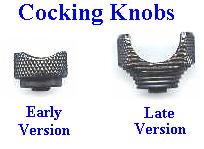
UZI Construction Details
 |
UZI Construction Details |
The UZI has remained essentially unchanged during its 50+ year history, but there have been a series of minor modifications. These variations have no particular designation but basically far into three groups: “early type”, “standard type” and “improved type”.
The early type was introduced in 1951 and produced for a very brief time. It used either wood or a fiber composition for the forearm and pistol grip. The standard model was produced from the early 1950’s until 1960. It used high impact plastic for the forearm and pistol grip and is usually found with a short detachable wood stock, although it could be equipped with a long wood stock or a metal folding stock. The easiest way to spot a standard model is its small bolt retracting knob.
 The improved model appeared about 1960. It has a
significantly larger bolt retracting knob, plus some improvements making the
fire selector mechanism more positive, trying to prevent an occasional problem
that was seen in the standard model where full automatic fire could occur when
the selector was set to semi automatic.
The improved model appeared about 1960. It has a
significantly larger bolt retracting knob, plus some improvements making the
fire selector mechanism more positive, trying to prevent an occasional problem
that was seen in the standard model where full automatic fire could occur when
the selector was set to semi automatic.
The slot in the top cover of the Uzi was initially smooth but later models have a series of small serrations cut into the slot on the underside of the cover. These serrations lock the bolt if the retracting knob is accidentally released before being fully cocked. This locking forms an effective safety system against accidental discharges common to some submachine guns. This design feature first appeared in the second lot of UZI’s sold to West Germany in the early 1960’s.
Page Under Construction. More Info to Follow!
Copyright © 2003, UZITalk.com
International copyright laws
DO apply to
Internet Web Sites!
All Rights Reserved.
Last Modified: September 28, 2003
Contact:
librarian@uzitalk.com